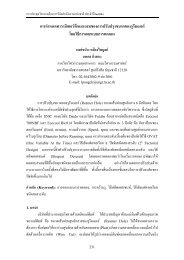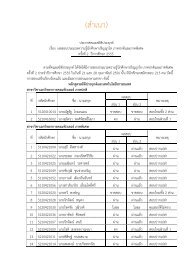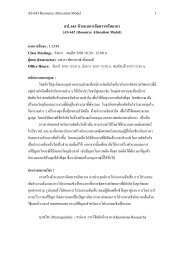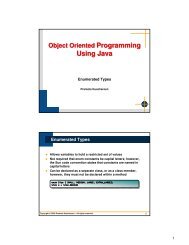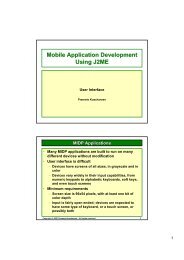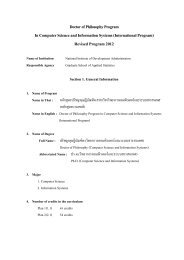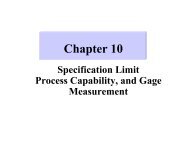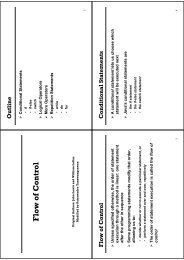ดาวน์โหลด All Proceeding - AS Nida
ดาวน์โหลด All Proceeding - AS Nida
ดาวน์โหลด All Proceeding - AS Nida
Create successful ePaper yourself
Turn your PDF publications into a flip-book with our unique Google optimized e-Paper software.
experimental analyses which consist of a base line analysis, an etched<br />
rate analysis and a circuit width analysis.<br />
Table 1. Responses and their Feasible Specifications.<br />
Response Specification<br />
Lower Upper<br />
Top Circuit Width 0.09 0.110<br />
Bottom Circuit Width 0.09 0.110<br />
4.1 Base Line Analysis<br />
In this first step, the experiments aim to analyse the current<br />
data of the circuit width (Rcw) by using a completely randomised design<br />
or one-way analysis of variance (ANOVA). The experimental designs<br />
were performed to determine the statistically significant process<br />
conditions or the capability of measurement system which consist of the<br />
pattern and sheet positions. The process positions and feasible ranges<br />
are provided in Table 2.<br />
Table 2. Process Positions and their Feasible Ranges.<br />
Position Level<br />
Pattern MT, Cen1, Cen2, OP<br />
Sheet S1 – S15<br />
In this study, at 95% confidence interval sources of variance<br />
and P-value were shown in Table 3. On the numerical results, the<br />
significant factor on both circuit widths is the pattern position. The<br />
pattern position is then applied as the design factor for the next two<br />
steps throughout.<br />
Table 3. ANOVA for Base Line Analysis.<br />
Source or<br />
Position<br />
P-Value<br />
Top Circuit Width Bottom Circuit Width<br />
Pattern 0.00 0.00<br />
Sheet 0.46 0.59<br />
54<br />
4.2 Etched Rate Analysis<br />
According to the results from the base line analysis the<br />
circuit width is unbalanced so the response in the second step is the<br />
etched rate (RER). Currently the etched rate is with the deviation of<br />
0.033 and the three sigma level of 6.1 as shown in Fig. 4. A two level<br />
experimental design with additional four centre design points was<br />
performed to determine the statistically significant process variables of<br />
A, B and C (an attribute factor). The low and high levels including<br />
centre points are selected cover values of feasible ranges in a production<br />
line (Table 4).<br />
The objective at this step is to analyse main and interaction<br />
effects via 20 treatments without a replication. The analysis of variance<br />
revealed that the main effects of A and B are significant, but there was<br />
no statistically significant on the interaction effect at 95% confidence<br />
interval.<br />
Frequency<br />
40<br />
30<br />
20<br />
10<br />
0<br />
42<br />
44<br />
Histogram of Etched rate (Current)<br />
Normal<br />
46 48<br />
Etched rate<br />
50<br />
Fig.4 Current Etched Rate Performance Measure.<br />
52<br />
54<br />
Mean 46.57<br />
StDev 2.033<br />
N 198<br />
Table 4. Process Variables and their Feasible and Tested Levels for<br />
Etched Rate Analysis.<br />
Process Feasible<br />
Tested Levels<br />
Variable Level Low Centre High<br />
A 30 – 60 30 45 60<br />
B 2.0 – 4.0 2.9 3.0 3.1<br />
C Attribute 1 - 2




